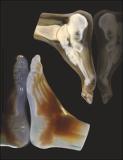From Improved Diagnostics to Presurgical Planning: High-Resolution Functionally Graded Multimaterial 3D Printing of Biomedical Tomographic Data Sets
Author(s)
Hosny, Ahmed; Keating, Steven John; Dilley, Joshua D.; Ripley, Beth; Kelil, Tatiana; Pieper, Steve; Kolb, Dominik; Bader, Christoph; Pobloth, Anne-Marie; Griffin, Molly; Nezafat, Reza; Duda, Georg; Chiocca, Ennio A.; Stone, James R.; Michaelson, James S.; Dean, Mason N.; Oxman, Neri; Weaver, James C.; ... Show more Show less
DownloadPublished version (1.523Mb)
Terms of use
Metadata
Show full item recordAbstract
Three-dimensional (3D) printing technologies are increasingly used to convert medical imaging studies into tangible (physical) models of individual patient anatomy, allowing physicians, scientists, and patients an unprecedented level of interaction with medical data. To date, virtually all 3D-printable medical data sets are created using traditional image thresholding, subsequent isosurface extraction, and the generation of .stl surface mesh file formats. These existing methods, however, are highly prone to segmentation artifacts that either over- or underexaggerate the features of interest, thus resulting in anatomically inaccurate 3D prints. In addition, they often omit finer detailed structures and require time- and labor-intensive processes to visually verify their accuracy. To circumvent these problems, we present a bitmap-based multimaterial 3D printing workflow for the rapid and highly accurate generation of physical models directly from volumetric data stacks. This workflow employs a thresholding-free approach that bypasses both isosurface creation and traditional mesh slicing algorithms, hence significantly improving speed and accuracy of model creation. In addition, using preprocessed binary bitmap slices as input to multimaterial 3D printers allows for the physical rendering of functional gradients native to volumetric data sets, such as stiffness and opacity, opening the door for the production of biomechanically accurate models.
Date issued
2018-05Department
Massachusetts Institute of Technology. Media LaboratoryJournal
3D Printing and Additive Manufacturing
Publisher
Mary Ann Liebert Inc
Citation
Hosny, Ahmed et al. "From Improved Diagnostics to Presurgical Planning: High-Resolution Functionally Graded Multimaterial 3D Printing of Biomedical Tomographic Data Sets." 3D Printing and Additive Manufacturing 5, 2 (June 2018): 103-113 © 2018 Mary Ann Liebert Inc.
Version: Final published version
ISSN
2329-7662
2329-7670